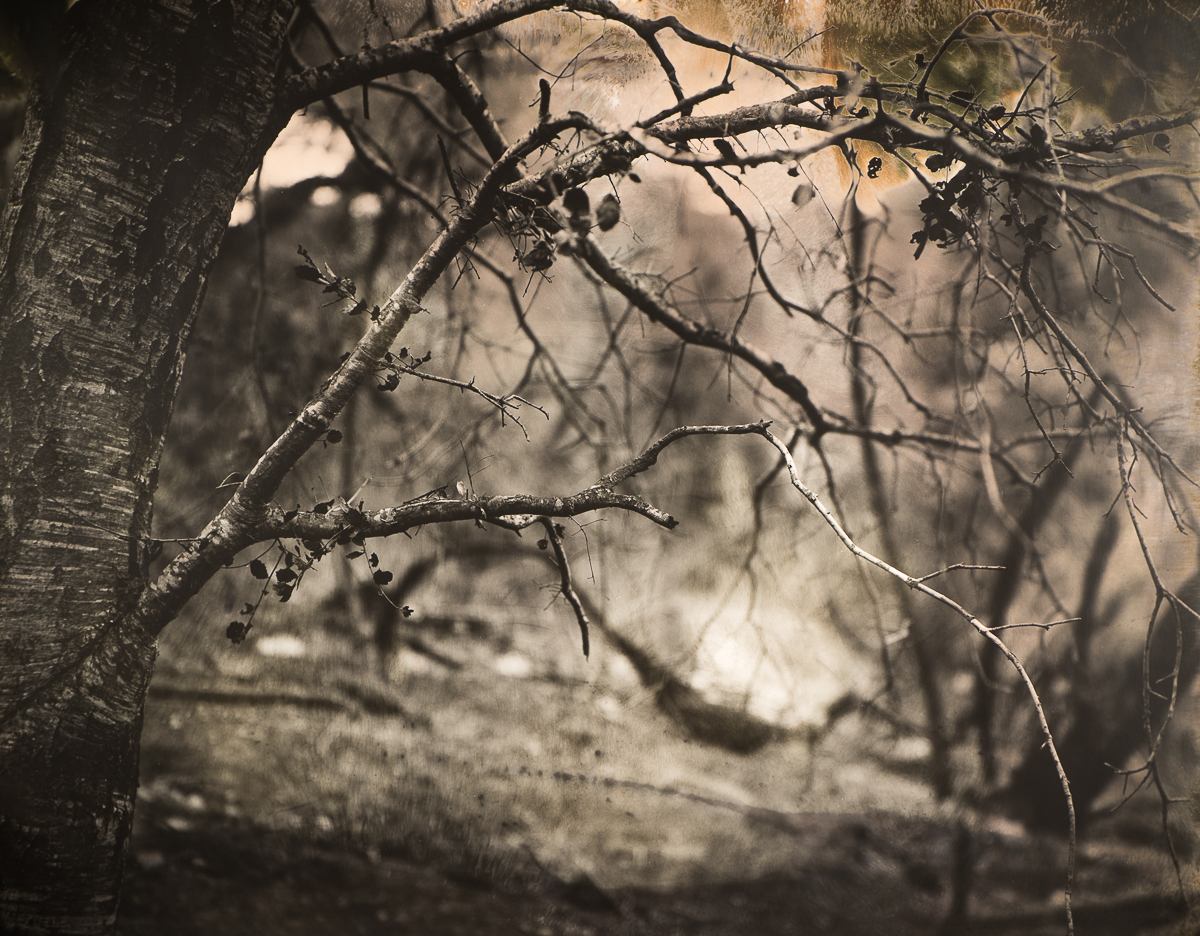Poignant Portfolio no. 6: Luther Gerlach
Thomas Fire Burn
by Luther Gerlach
The 2017 Thomas Fire is the largest in California history, an extreme example of a powerfully destructive and creative cycle endemic to the region. The burn came within a quarter mile of my home, and as the smoke cleared, I was struck by how it had abstracted the landscape, leaving white shadows of ash where trees had been and turning a once-colorful forest black, rendered completely bare of undergrowth. Only the strongest features remained.
These images were created with an 8x10” wooden view camera and enlarged to allow the viewer access to an incredibly detailed account of the destruction wrought by the fire. I collected ashes and sulfur-laden water from hot springs at the origin point, Thomas Aquinas College. It is almost as if these chemical catalysts carry a memory of the fire, acting on the print to produce ghostly effects such as swirling apocalyptic skies and suggestions of the trees that once stood. Applied to the developed prints, the ash and sulfur attack the silver, transforming the monochrome image into fiery color, with licks of red, orange, green, and brown. The result is not only a documentation of destruction, but also a vision of the beauty rendered by it.
Photographer Luther Gerlach works in a variety of historical photographic processes, highlighting the role of constraints in creative production and the hand-made, tactile connection between the artist and his work. Known for nude portraits and urban scenes of downtown LA in his early career, more recently Gerlach has pioneered the re-emergence of plein air wet plate collodion landscapes. His work distills detailed images of the natural world, particularly the trees, seaweeds, and grasses of Southern California, to emphasize pure light and line, endowing his images with a subtly abstract quality.
Luther Gerlach was born in Tenterden, Kent in 1960. He grew up in Blayne, Minnesota. Gerlach apprenticed with Brett Weston in Carmel and Hawaii in the 1980’s, before learning the wet plate process which he still works in today. He has led lectures and demonstrations at the J. Paul Getty Museum in Los Angeles since 2001. Gerlach has exhibited at the Santa Barbara Museum of Art, the Ventura Museum of Art, the Schaknow Museum of Fine Art, Miami, the Denver Art Museum, and The Palace of the Governors, Santa Fe. Selected permanent collections include the Los Angeles County Museum of Art, The J. Paul Getty Museum, and the Michael G. Wilson Centre for Photography, among others.
Gerlach currently lives and works in Ventura, California.
From the Editor
“In October 2017, my family and friends in Santa Rosa, California evacuated their homes due to the threat of the Tubbs Fire, which is considered one California’s most destructive wild fires. Many members of my family gathered together in an RV and truck camper to wait out the fire. Luckily all of their homes were spared, but 5,636 other structures were burned down as it tore through the city. A few months later, California would see it’s largest acreage wild fire, The Thomas Fire, as it hit Ventura and Santa Barbara counties.
When Gerlach’s Thomas Fire Burn submission arrived in my inbox, my heart leaped. His photographic interpretation of the destruction of the Thomas Fire is so symbolic. The use of ash and sulfur water in the print process brings the destructive narrative to the forefront. Ultimately, these prints, as heartbreaking as the subject matter is, are quite beautiful.”















